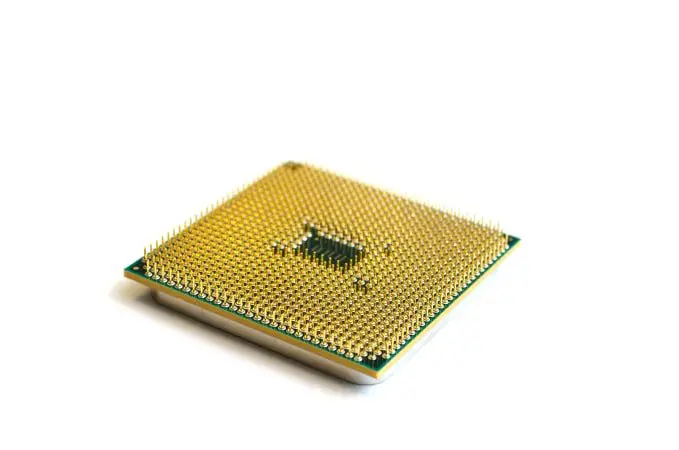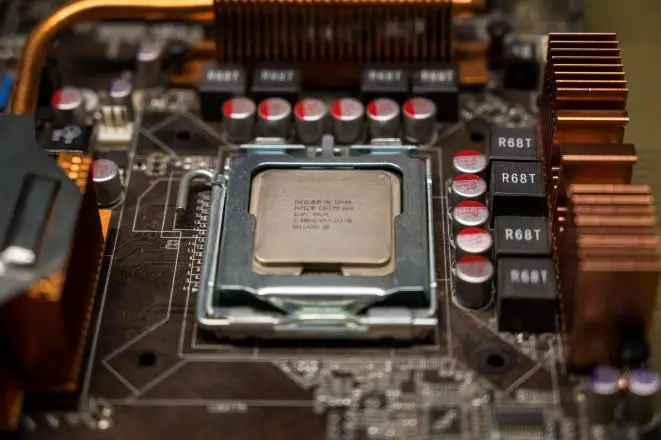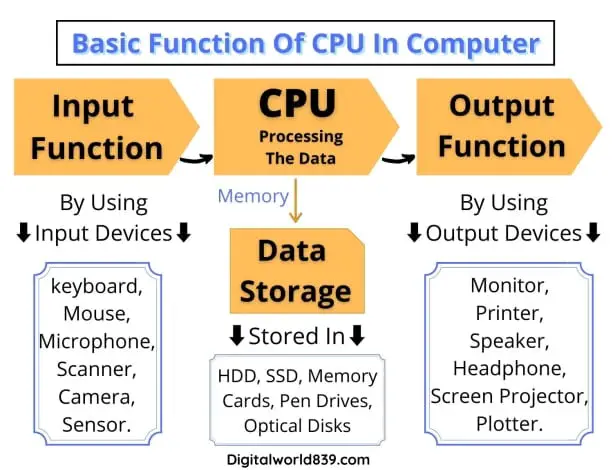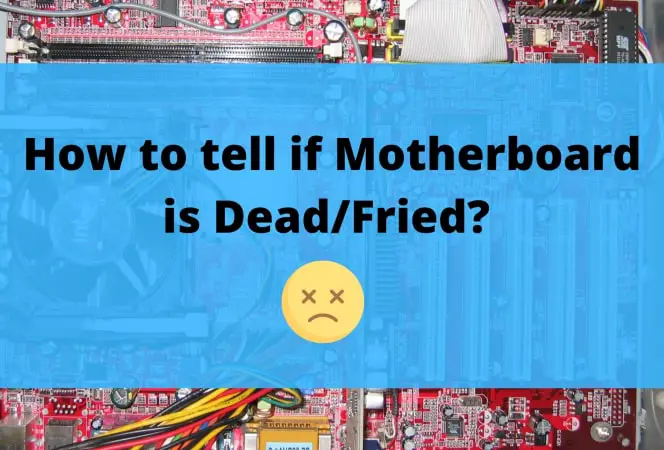The computer needs various important components to work properly and efficiently. One of the core parts is the CPU (Central Processing Unit). Now the question is What is this CPU? what is the function of CPU? & How CPU works?.
So do not worry. You will get answers to all the questions related to the CPU. In this article, I will explain the core function of CPU and its contribution to the computer system in simple terms.
What is CPU?
CPU or Central Processing Unit is computer hardware that carries out a computer’s instructions and controls all the arithmetical, logical, and input/output operations of a computer system.
In short, all the data processing operations within a computer are controlled by the CPU.

CPU is also called a processor, or central microprocessor processor, etc. It receives all the instructions, either it is from software applications or hardware components. Therefore, it is a very major part of the computer.
CPU is the most important part of a computer system in terms of computing power. Its processing components have a huge contribution to working the computer. The speed and power of a computer significantly depend on the CPU (Processor).
Good to know ~ The first microprocessor was invented by Intel in the 4th generation of computers (Year 1971).
Where CPU is located in the computer?
This CPU is placed on the CPU socket center around the VRM section of the motherboard connected with the other hardware elements inside the computer cabinet. The CPU is a square shape chip in view, consisting of a thin layer of thousands of transistors.

CPUs are made so that microscopic transistors could place in a single microcomputer chip in the number of billions.
With these transistors’ help, all the calculations are done, and the processor receives input from peripherals like (Keyboard, Mouse, microphone, etc.). After processing, it sends the result to the output device.
What is the Function of CPU in Computer?
The main function of CPU in the computer is to store and process by performing all the mathematical and logical calculations with the input data to provide the output data to the users, thereby working on the computer.
The function of CPU in 4 Steps:
- The CPU receives the data when the computer inputs the data through input devices such as a keyboard or mouse.
- After this, the CPU process these input data by performing calculations and technical algorithm.
- And then CPU provides the processed data through output devices such as on the monitor screen.
- The CPU also stores the process data in the form of a cache for future use.

You have understood the whole CPU function works in simple words from these four steps, and amazing isn’t it?. Thus, every operation or task that we perform in our computer is similarly processed by the CPU.
For Example:
When you press any key on your keyboard, either it is an alphabet, numerical or special symbol. The keyboard converts it into computer language (Binary Code, i.e., 10100). Then CPU calculates how to display the letter input pixel by pixel on the computer screen.
The CPU requests step-by-step instructions from memory to draw the letter or whatever you have pressed on the keyboard runs these instructions, and stores the results as pixels in memory. Finally, this pixel information is sent in binary to the screen.
The screen is an output device, which converts the binary signals into the tiny lights and colors that make up what you see. This is same in the case of mouse from which you cursor/pointer on the screen. The function of CPU is not only limited to the computer screen but also other output devices of the computer like Speaker, Printer, Projector, etc.
How CPU (Central Processing Unit) Works?
Since creation and development, improvement of the CPU, Fetch, Decode and Execute are the fundamental functions of the CPU. Let us know the function of each of them in detail.

1. Fetching
As the word suggests, the first CPU receives the instruction. That means the series of binary numbers that are passed from RAM to CPU.
The CPU does not directly receive a single instruction. However, rather the instructions are separated into several sets in memory. That implies many small building blocks of a long process are made. After which, the CPU receives those pieces of instruction one by one.
Since the data is in a disordered manner, when an instruction is divided into several smaller sets, the program counter (PC) holds the instructions’ addresses to provide the instructions serial wise to perform as per the need.
In this way, the CPU gets to know the order of receiving the instructions. These instructions are stored in the IR (Instruction Register). Once this is completed, the program counter will continue to reference its following instructions address.
2. Decoding
Once the instruction is loaded into the CPU, it needs to work out what the instruction means. After which the process of decode begins with the help of ALU (Arithmetic Logic Unit).
It performs logical and arithmetic operations and necessary calculations, which manages the computer’s various components; it reads and interprets instructions from memory and transforms them into a series of signal forms that are then passed to different parts of the CPU so that further action can be taken.
3. Executing
At last, decoded instructions are executed. Finally, the computer has to carry out the instruction during the execution step. This could be many things, including loading data from memory, storing data in memory, or performing a calculation.
After which, they are stored in the CPU register as output so later instructions can reference them.
After this, as per the user’s instructions, it is either given to the output device, or it is stored on the computer system, or even stored on secondary storage devices.
The processor will carry out this cycle over and over millions of times per second. This is how the CPU works.
Conclusion
So in this way, the processor or CPU is responsible for executing all the processes. That’s why, without a central processing unit, computers and laptops would not be able to do anything with the data they store.
Because the CPU must continue to operate continuously, causing much load is on the CPU, it often heats up.
To avoid this heat, a cooling fan is installed on the CPU. The heat sink is also fitted with fan-based thermal paste; it is a heat conductive paste so that the processor continues its work properly.
When it comes to device speed and high performance, the CPU has the most role in it. If you want a fast computer for performing 3D animation, editing video files, intense gaming, etc. In this case, it is very important to have a fast and efficient processor.
Therefore, whatever technological advances have been made in processor technology, speed has been the most important reason behind them.
FAQs
Why CPU is important?
The CPU, or central processing unit, is accountable for processing all the software and hardware’s instructions and data, so it is an important component of the PC. Its consistency is with the end goal that, conversationally, it has been defined as the computer’s brain.
Why is the CPU called the brain of the computer?
Just like our brain manages all the functions in our body like blood circulation and digestion. Similarly, in a computer, the CPU controls all the important functions like Input, Processing, Data storage, Output. That is why the CPU is called the brain of the computer.
What are the components of CPU?
The components of the CPU are the arithmetic logic unit (ALU), control unit (CU), registers, cache, buses, and clock. These CPU components are used in the functioning of a microprocessor.
What are the types of CPU?
The major types of CPU are classified as a core that is single-core, dual-core, Quad-core, Hexa core, Octa-core, and Deca core processor. In addition, these core processors are further classified in different architectures like 64 bit and 32 bit with different speeds and capacities.
What are the 3 main functions of CPU?
The 3 main functions of the CPU are fetching, decode, and execution. With the use of CPU components this function occurs as per the instructions. The processer carries out this cycle over and over millions of times per second.
Are CPU and processor the same?
Yes, both the CPU and processor are the same when referring to modern computers and laptops. However, CPU is also used as a broad term for a machine, and the processor is used as a main working chip for a computer. That is why it is also known as a microprocessor and central processor.
Why CPU is situated under the heat sink?
The CPU gets very hot while performing millions of calculations; that’s why the CPU is under the big piece of metal called the heat sink to get the heat away from the processor before it damages it.
I hope you get the answer to what is the function of cpu in computer and how cpu works. Share the post to everyone to get know the working of CPU easily.




